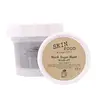What's inside
What's inside
 Key Ingredients
Key Ingredients

No key ingredients
 Benefits
Benefits

 Concerns
Concerns

 Ingredients Side-by-side
Ingredients Side-by-side

Caprylic/Capric Triglyceride
MaskingSucrose
HumectantDisteardimonium Hectorite
StabilisingSorbeth-30 Tetraoleate
EmulsifyingRosmarinus Officinalis Leaf Oil
MaskingEuphorbia Cerifera Wax
Coix Lacryma-Jobi Ma-Yuen Seed Powder
Humectant1,2-Hexanediol
Skin ConditioningCaprylyl Glycol
EmollientWater
Skin ConditioningMalt Extract
Skin ProtectingLimonene
PerfumingSimmondsia Chinensis Seed Oil
EmollientLimnanthes Alba Seed Oil
Skin ConditioningMacadamia Integrifolia Seed Oil
Skin ConditioningHoney Extract
HumectantGlycerin
HumectantCaprylic/Capric Triglyceride, Sucrose, Disteardimonium Hectorite, Sorbeth-30 Tetraoleate, Rosmarinus Officinalis Leaf Oil, Euphorbia Cerifera Wax, Coix Lacryma-Jobi Ma-Yuen Seed Powder, 1,2-Hexanediol, Caprylyl Glycol, Water, Malt Extract, Limonene, Simmondsia Chinensis Seed Oil, Limnanthes Alba Seed Oil, Macadamia Integrifolia Seed Oil, Honey Extract, Glycerin
Sucrose
HumectantPEG-7 Glyceryl Cocoate
EmulsifyingGlycerin
HumectantEuphorbia Cerifera Wax
Macadamia Ternifolia Seed Oil
EmollientCaprylic/Capric Triglyceride
MaskingCetyl Ethylhexanoate
EmollientLanolin
EmollientStearalkonium Hectorite
Gel FormingButyrospermum Parkii Butter
Skin ConditioningLimnanthes Alba Seed Oil
Skin ConditioningCaramel
Cosmetic ColorantSorbitan Laurate
EmulsifyingTocopheryl Acetate
AntioxidantEthylhexylglycerin
Skin ConditioningWater
Skin ConditioningParfum
MaskingSucrose, PEG-7 Glyceryl Cocoate, Glycerin, Euphorbia Cerifera Wax, Macadamia Ternifolia Seed Oil, Caprylic/Capric Triglyceride, Cetyl Ethylhexanoate, Lanolin, Stearalkonium Hectorite, Butyrospermum Parkii Butter, Limnanthes Alba Seed Oil, Caramel, Sorbitan Laurate, Tocopheryl Acetate, Ethylhexylglycerin, Water, Parfum
 Reviews
Reviews

Ingredients Explained
These ingredients are found in both products.
Ingredients higher up in an ingredient list are typically present in a larger amount.
This ingredient is an emollient, solvent, and texture enhancer. It is considered a skin-softener by helping the skin prevent moisture loss.
It helps thicken a product's formula and makes it easier to spread by dissolving clumping compounds.
Caprylic Triglyceride is made by combining glycerin with coconut oil, forming a clear liquid.
While there is an assumption Caprylic Triglyceride can clog pores due to it being derived from coconut oil, there is no research supporting this.
Learn more about Caprylic/Capric TriglycerideGlycerin is already naturally found in your skin. It helps moisturize and protect your skin.
A study from 2016 found glycerin to be more effective as a humectant than AHAs and hyaluronic acid.
As a humectant, it helps the skin stay hydrated by pulling moisture to your skin. The low molecular weight of glycerin allows it to pull moisture into the deeper layers of your skin.
Hydrated skin improves your skin barrier; Your skin barrier helps protect against irritants and bacteria.
Glycerin has also been found to have antimicrobial and antiviral properties. Due to these properties, glycerin is often used in wound and burn treatments.
In cosmetics, glycerin is usually derived from plants such as soybean or palm. However, it can also be sourced from animals, such as tallow or animal fat.
This ingredient is organic, colorless, odorless, and non-toxic.
Glycerin is the name for this ingredient in American English. British English uses Glycerol/Glycerine.
Learn more about GlycerinLimnanthes Alba Seed Oil is the oil extracted from the seeds of the meadowfoam plant. This oil is non-fragrant and is an emollient. As an emollient, meadowfoam seed oil helps soften and hydrate the skin.
Meadowfoam seed oil is stable and has a long shelf life due to its chemical structure. It has the highest concentration of stable fatty-acids among plant oils, preventing it from degrading once exposed to oxygen.
Due to the fatty acid content, this ingredient may not be fungal-acne safe.
Meadowfoam is native to California and Oregon.
Learn more about Limnanthes Alba Seed OilSucrose is a natural sugar found in fruits, vegetables, and nuts. It is the main constituent of white sugar.
In skincare, sucrose is a humectant and can be a mild exfoliant.
Sucrose is hydrophilic, meaning it attracts water. This makes it an effective humectant and helps hydrate the skin.
Studies show sugars may worsen acne-prone skin due to it disrupting the skin's natural biome. We recommend speaking with a professional if you have any concerns.
In some products such as body scrubs, sucrose is used as an gentle exfoliant.
The term 'sucrose' comes from the french word for sugar, 'sucre'.
Learn more about SucroseWater. It's the most common cosmetic ingredient of all. You'll usually see it at the top of ingredient lists, meaning that it makes up the largest part of the product.
So why is it so popular? Water most often acts as a solvent - this means that it helps dissolve other ingredients into the formulation.
You'll also recognize water as that liquid we all need to stay alive. If you see this, drink a glass of water. Stay hydrated!
Learn more about WaterEuphorbia Cerifera wax comes from a shrub in Northern Mexico. It is used to stabilize formulations and has emollient properties.
Emollients form a thin layer on top of skin to prevent water from evaporating, keeping skin and lips hydrated.
According to a manufacturer, this wax can range from a yellow/brown color to translucent.
Learn more about Euphorbia Cerifera Wax